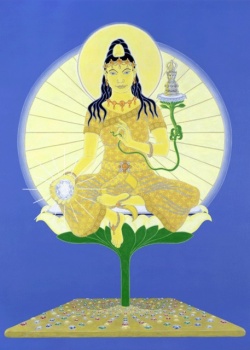Mamaki
Mamaki (Skt. Mamakī; Tib. མ་མ་ཀི་, Mamaki; Wyl. ma ma ki) — one of the five female buddhas and the consort of Ratnasambhava.
Mamaki (Skt. Mamaki; Tib. ???????, Mamaki; Wyl. ma ma ki) — one of the five female buddhas and the consort of Ratnasambhava.
Mamaki is another important deity who is said to be originated from seed syllable, Mam. Mamaki is blue in colour. Mamaki is the embodiment of the water element. Mamaki belongs to vajra family and is the nature of hatred. Her recognition symbol is Vajra. Mamaki is the consort or Prajna of Buddha Akshobhya. Her another name is Dvesarati.
Mamaki resides in the south west corner. Mamaki too has many forms. She can be found in two armed, six armed, eight armed and twelve armed forms. In two armed form she is depicted holding a vajra with her right and her left hand resting on her thigh. In another case she is seen displaying varada mudra with her right hand and the stalk of an utpala with her left.
According to Tantric Buddhist symbolism of Newar Buddhist tradition there is a special ritual worship of Mamaki in the form of triad ritual objects (Newari: Anti, Khayakori and Thapin). The Newari word Anti is a special jar used for keeping fermented wine, Khayakori for Yoghurt and Thapin for keeping fermented beer.
Mamaki is the golden yellow female Buddha of the South, the consort of Ratnasambhava. In one recent painting of Mamaki, she sits in a jewelled background (she belongs to the Ratna or jewel family). The jewels prompt reflections on the multi-facetted associations of precious gems.
Mamaki, greedy, Buddhist goddess, is the Shakti of Ratnasambhava or Aksobhya, also a bodhisattva or future buddha. She originated from the blue mantra MAM. Her color is yellow or blue, and attributes are cup, flowers, jewel, knife, and staff. A.G.H.
Mamaki, who is Ratnasambhava’s consort. Her name means “she who makes everything her own.” Mamaki looks on all things as identical with herself, because she knows the inner unity of Shunyata or emptiness which lies at the heart of all beings.
She delights in and appreciates everyone and everything. Mamaki A goddess. A shakti of Akshobhya or of Ratnasambhava. Mother of Vajrapani.
Mamaki. One interpretation of her name is “the mine maker” (Identifying with everyone). Equality & Abundance. The element of water, which exists within us as a certain energy, is transformed or ripened to become Mamaki
The image has been drawn out of and based on the book written by Vessantara, ‘The Five Female Buddhas’ 2004.
Time of day: noon
Emblem: jewel
Seed-syllable: MAM
Magical function: increasing
The Pure Land of Ratnasambhava is in the south, called Shrimat.
In Bardo Thodol, Tibetan Book of the Dead, he is depicted in union with his female consort Mamaki and attended by the male bodhisattvas Akashagarbha and Samantabhadra and the female bodisattvas Mala and Dhupa.
Together with his consort Mamaki he sits on the throne supported by horses.
He is accompanied by two bodhisattvas Akashagarbha and Samantabhadra, and two bodhisattvas, Mala and Dupa. Altogether in the space of rainbow light six images of Buddhas are shining. The yellow light of aggregate of senses (vedana-skandha) in its pure dimension is a Wisdom of Equality - radiant, decorated with disks of rainbow light, bright and sparkling, unbearably bright to the eye, will radiate from the heart of Ratnasambhava and his consort into your heart ...”
The female Buddhas are Locana, consort of Akshobya, Mamaki, consort of Ratnasambhava, Pandaravasini, consort of Amitabha, Tara, consort of Amoghasiddhi, and Akashadhateshvari, consort of Vairocana. These male and female figures are depicted in sexual union.
Strangely for us perhaps this has nothing to do with sex, there is no erotic content to these images. This is sexual symbolism.
In the Tantra this is profound and sacred symbolism, expressing the highest Truth. These images, known as Yab-Yum, are symbolic of the unity or oneness of Wisdom and Compassion.
The female Buddha represents the Wisdom aspect and the male Buddha represents the Compassion aspect, which is the active aspect of Enlightenment. The sexual embrace symbolizes the fact that there is no distinction between Wisdom and Compassion, they are just two ways of speaking about, or two ways of seeing, what is in fact a total experience. So, the final message of the five Wisdoms is that Wisdom is Compassion.
